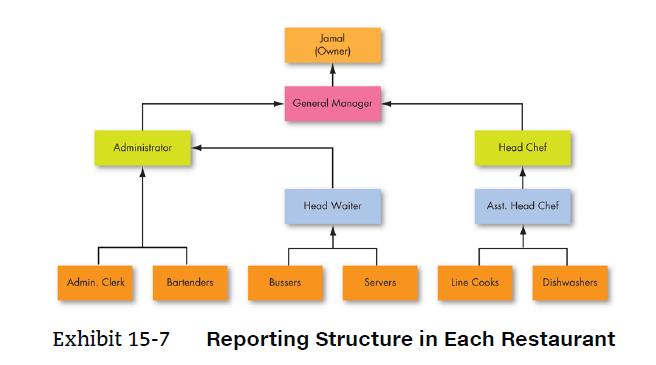Jamel stared at the organization chart in front of him one more time and sighed. He still
Question:
Jamel stared at the organization chart in front of him one more time and sighed. He still wasn’t sure about the right thing to do. Jamel owned a chain of specialty gastropubs. His pubs were located in 10 diverse areas across Southern Ontario, each with a very different consumer profile. His Scarborough restaurant, for example, was in a neighbourhood dominated by young immigrant families from Southeast Asia, his Oshawa pub was near several factories at the outskirts of the city and attracted large numbers of farmers and older line workers, his Mississauga pub was frequented by middle-aged office workers from a wide range of backgrounds, and his Georgetown pub attracted a retired European crowd.
Early on, Jamal had decided that the best way to manage restaurants in such disparate neighbourhoods was to decentralize decision making. He therefore departmentalized several key functions by geography, including food purchasing, menu planning, hiring, and advertising. Each store had its own general manager, head chef, assistant head chef, administrator (for food purchasing, advertising and marketing contract administration, hiring, etc.), part-time assistant administrative clerk (for staff scheduling and payroll), and head waiter. There were also line cooks, dishwashers, servers, bartenders, and bussers.
Exhibit 15-7 outlines the reporting relationships within each individual restaurant. The general manager reported directed to Jamal. The administrator reported to the general manager. The head chef, who was responsible for menu planning, experimentation, kitchen staff culinary training, and cooking for special VIP events, also reported to the general manager. The assistant head chef reported to the head chef and managed the line cooks and dishwashers. The assistant head chef was the primary supervisor day to day in the kitchen, did a lot of cooking personally, and was responsible for expediting order (ensuring quality control). The assistant administrative clerk, head waiter, and bartenders reported to the administrator. Bussers and servers reported to the head waiter.
The staff members of each individual restaurant were trained separately and knew the menus and processes used in their own establishment. The processes were established by the general managers and were not necessarily consistent between facilities. This being so, it was difficult for a server or bartender in one restaurant to cover a shift in another. This was inconvenient, as unexpected turnover was not uncommon in the industry and special events like a local festival might drastically (but temporarily) increase demand at one location. In addition, each restaurant had separate contracts with food suppliers and local advertisers such as radio shows and newspapers. These contracts were negotiated by the administrators, who send out bids and made plans in isolation.
Three years after initially deciding upon decentralization and geographic departmentalization, Jamal is now wondering if he made the right choice.
Each pub has high customer satisfaction ratings and high numbers of repeat customers. Each pub fits well into its community and has become a social hub for the neighbourhood. His payroll costs, however, represent anywhere from 42 to 47 percent of gross sales. He has reviewed industry benchmarks published by expert Baker Tilly, and has noticed that comparable full-service restaurants have average staffing costs that are only 30 to 35 percent of their gross sales. His pubs simply aren’t profitable enough.
Jamal has tried controlling food costs and has invested in staff training and process efficiencies, but his cost structure remains high due to the excessive staffing costs. The head chef roles in particular require comparatively high salaries in order to attract competent talent who will generate excitement and contribute to the gastropub brand.
Jamal is afraid that any changes or standardization will make him lose his market focus and competitive edge. Layoffs might be the answer, but then customer service will be impacted and he will have even fewer people available to call on when sporadic staffing shortages occur. After careful consideration he decided on a structure that would look like this . . .
Discussion Questions
1. What type of organizational structure would you recommend for Jamal? Why?
2. What are the risks of your proposed structure? How might you counter those risks?
Step by Step Answer:

Essentials Of Organizational Behaviour
ISBN: 9780134182971
1st Canadian Edition
Authors: Stephen P. Robbins, Timothy A. Judge, Katherine Breward





